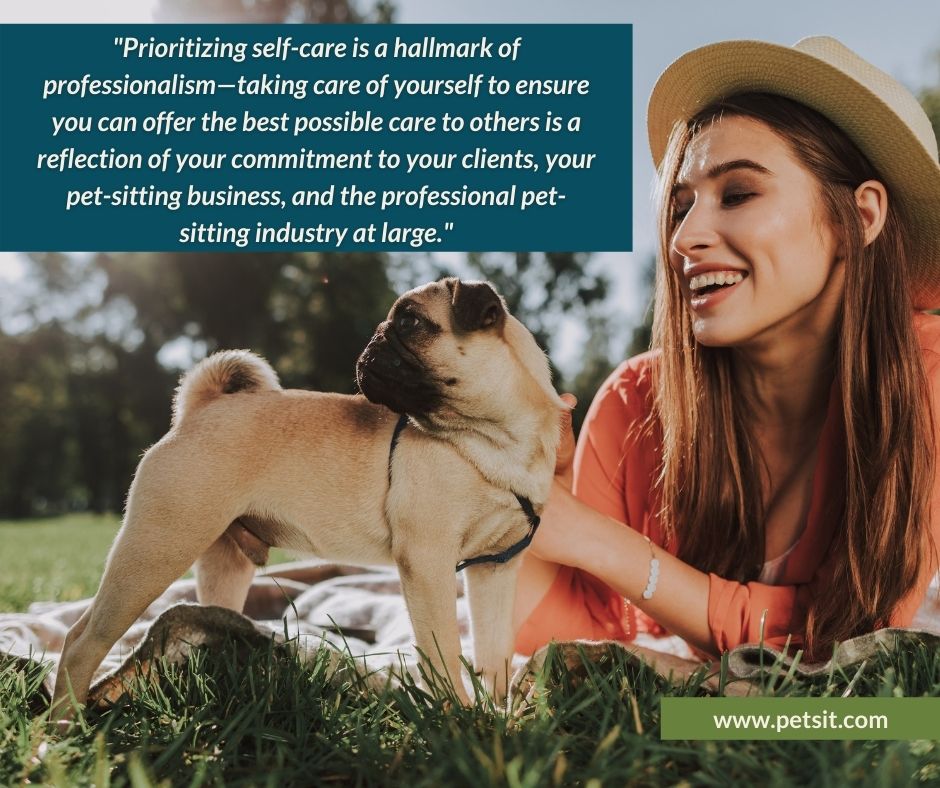4 Self-Care Tips for Pet Sitters and Dog Walkers this Year
By Beth Stultz-Hairston | Updated January 2022

It’s a mantra repeated in the professional pet-sitting industry (and to all small-business owners, really): Run your business, don’t let it run you.
Great advice—but advice that’s often easier shared than heeded.
Even professional pet sitters who feel confident that they are successfully managing their businesses often struggle with “unplugging” from their work—and find when they aren’t pet sitting or working in or on their businesses, they are still thinking about their businesses.
“Self-care” has become a phrase we hear often...from physicians, psychologists and business consultants as they stress the benefits of work-life balance and encourage an increased focus on physical and mental well-being.
Perhaps the reason “self-care” is mentioned so often is because so few small-business owners are heeding the advice—and professional pet sitters and dog walkers are no exception.
While running a small business—particularly one in the pet-care services industry—seems to leave little time for much else, it does not mean that you have to put yourself at the bottom of your to-do list. In fact, moving yourself higher up on your list could be one of the best things you can do for your pet-sitting business this year.
As you make plans for your business this year, keep these self-care tips in mind:
1. Establish and maintain business boundaries.
Having policies and procedures in place isn’t just a business best practice, it’s also vital for your own self-care. Having set business hours (in which you communicate with current and potential clients), being clear on your cancellation policy and payment terms, and having guidelines for how/when clients can book services, for example, are not just policies that streamline your business—they can also help prevent you from burning out.
For many pet sitters and dog walkers, slow time during the pandemic has offered an opportunity to revisit their business practices. As we prepare for the impending flood of pet-sitting requests likely to come once safe travel can resume again, it’s the perfect time to revisit your business practices.
2. Learn when and how to say no.
Remember, you do not have to accept every client who contacts you and you don’t have to take on every pet-sitting request, even if it is from a current client. With so much business lost during the pandemic, it may be tempting to take on every request you receive this year, but do not make that mistake.
It’s important to recognize your limitations and know how many visits you can complete in a day without compromising the care you provide or jeopardizing your health. Schedule aside, there are other pet-sitting assignments you should turn down because they make you feel uncomfortable or simply aren’t a good fit.
The best way to be able to say “no” (and to not feel as guilty about it) is to plan ahead—know when you are at capacity or what types of assignments you will not accept, then have a response ready. This way, you will not be caught off guard and will not feel pressure to simply give in and say “yes.”
This recent post from PSI shares examples of pet-sitting assignments to turn down with advice on how to decline the requests.
For example, if turning away clients when you are booked is difficult for you, network with another local sitter in advance that you will feel comfortable referring them to. This way, when a last-minute pet owner calls, you can have the confidence to say, “I would love to be able to care for Fluffy, but I cap my schedule at a certain number of visits to ensure all furry clients receive the absolute best possible care. However, I know a wonderful professional pet sitter who also services your area that I can refer you to this time—but I’m happy to take your information to put you on my email list and would love to pet sit for you in the future.”
3. Take time off—each day and for vacations.
Not taking days off is one of the quickest ways to burn out in this business. As a service provider, you’ll likely feel like there’s never a “good” day to take off, but planning and notifying your clients in advance allows you to take vacations with less guilt (if you are a solo sitter). If you have staff, having staff sitters you trust and having processes in place that allow you to be away with minimal interruption to your business (and minimal interruptions to you!) will enable you to enjoy time away. If scheduling multiday vacations isn’t in the cards for you at your current stage in business, schedule long weekends or a day off in the middle of the week occasionally to allow yourself to recharge.
Taking time away from your business shouldn’t just be reserved for vacation days. You need time away from your business each and every day. Set office hours and make sure your clients know when you will and will not be available. Many pet sitters use their phones’ “do not disturb” feature at night or only give their cell phone numbers to active clients who may need to reach them in the event of an emergency. It’s also important to decide on and stick to specific times for checking and returning emails and phone calls so you are not always tied to your phone or computer.
4. Build a strong support network.
This industry has unique challenges, and it’s important to have others who understand the daily joys and struggles of pet sitting. Network with local pet sitters and take advantage of opportunities like PSI’s annual conferences and PSI’s free private member Facebook group to make connections with pet sitters from around the globe. There’s likely nothing you’ll experience in your pet-sitting business that has not been experienced by another pet sitter before—and having another pet sitter to offer advice or just kind words is invaluable.
"Never pass up an opportunity to connect with others in the pet industry. Your current struggle could be the very issue that another triumphed over last week—and is more than willing to help you overcome."
Prioritize your well-being this year!
Eliminate the idea that self-care is “selfish.” Most pet sitters, by nature, are giving, nurturing individuals. It’s that drive to help others (particularly pets) that likely motivated you to become a pet sitter, but with such a giving nature, you are susceptible to falling into the trap of giving, giving, giving and feeling guilty about making time for yourself.
Self-care is not a dirty word. In fact, prioritizing self-care is a hallmark of professionalism—taking care of yourself to ensure you can offer the best possible care to others is a reflection of your commitment to your clients, your pet-sitting business, and the professional pet-sitting industry at large.

Remember, if you aren’t taking care of yourself, you will not be able to take care of your pet-sitting business or your clients.
Pet sitting is not easy or for the faint of heart. You work long hours, have to routinely make major business decisions, are daily entrusted with the serious responsibility of caring for others’ pets and often find yourself weary dealing with the loss of clients’ pets—or even clients themselves.
Self-care is important. Burnout and compassion fatigue are very real issues in our industry—and, if left unaddressed, will begin to chip away at the professionalism of your business and the pet-sitting industry at large.
If you are unsure of what pet sitter burnout or pet sitter compassion fatigue are or how they are different, please be sure to read this previous post on The PSI Blog, “Pet Sitter Burnout and Compassion Fatigue—What you should know.”
Note: Many of the tips above can help pet sitters prevent burnout or work through compassion fatigue, but keep in mind these tips do not provide or replace advice from a health care or mental health care professional—so if your symptoms are not manageable, consult an expert!
What self-care practices will you be implementing this year? Let us know in the comments below.







Comments
Zara Willmott
Leticia
Heidi Lewis
Janet Reed